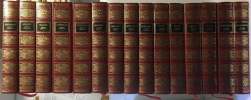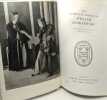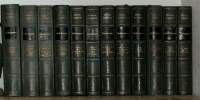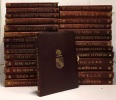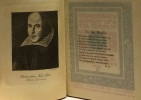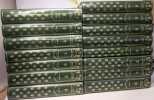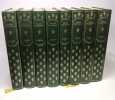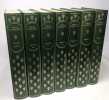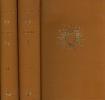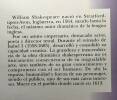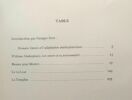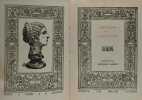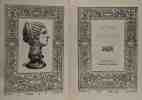2670 books for « shakespeare w »Edit
-
Type
Artists book (1)
Autograph (1)
Book (2755)
Drawings (1)
Posters (1)
-
Latest
Last 24h (2)
Last month (67)
Last week (2)
-
Language
English (11)
French (2490)
Italian (1)
Russian (257)
-
Century
18th (18)
19th (201)
20th (1324)
21st (77)
-
Countries
Belgium (132)
Canada (2)
Denmark (15)
France (2155)
Germany (1)
Greece (5)
Italy (5)
Netherlands (5)
Switzerland (180)
United States of America (259)
-
Syndicate
ALAC (1)
CLAM (5)
CNE (1)
ILAB (1298)
NVVA (14)
SLACES (14)
SLAM (1230)
SNCAO (1)
Topics
- Autographs (11)
- Beaumarchais (5)
- Belles lettres (7)
- Berthold mahn charles (7)
- Bibliophilism (16)
- Biography (8)
- Brittany (16)
- Chieze (3)
- Children’s books (12)
- Comedy (15)
- Comic strip (7)
- Complete - works (3)
- Dance & ballet (3)
- Dedication (5)
- Delacroix eugène (7)
- Drama (15)
- Drawings (4)
- Early printed books (7)
- Education (3)
- Education - morals (3)
- England (64)
- English (33)
- English literature (78)
- Engraving (books about) (3)
- Essays (4)
- Fin de siècle (6)
- Fine arts (5)
- First edition (43)
- Flammarion camille (3)
- Fontanarosa (3)
- Foreign literature (13)
- Gallimard (3)
- Germanic languages (22)
- Goethe johann wolfgang (4)
- Great britain (9)
- Helvética (10)
- History (5)
- Hugo victor (29)
- Illustrated books (19)
- Kafka franz (4)
- Language (5)
- Linguistics (11)
- Linton (5)
- Literature (190)
- Magazine (3)
- Méssiaen (5)
- Modern comic (13)
- Modern illustrated book (4)
- Molière j. b. poquelin (8)
- Newspapers press (4)
- Painting (3)
- Paris (5)
- Philosophy (3)
- Pléiade & album de la (30)
- Poetry (35)
- Policy (3)
- Reliure (7)
- Review (4)
- Reviews (4)
- School (3)
- Shakespeare william (694)
- Sheep (14)
- Story (4)
- Switzerland (10)
- Tales (7)
- Tea (4)
- Theatre (553)
- Tragedy (23)
- Translation (34)
- Typography (4)
- United kingdom (63)
- Various (40)
- Venice (4)
- Version (3)
- Williams tennessee (4)
- Xviith century (3)
Racine Musset Corneille Shakespeare Victor Hugo Molière Marivaux Beaumarchais
Reference : 100056550
(1989)
Collection Oeuvres complètes 8 volumes: Racine Musset Corneille Shakespeare Victor Hugo Molière Marivaux Beaumarchais (tome 2 de Shakespeare manquant reste complet en 2 volumes par auteur)
Crémille 1989 in4. 1989. reliure éditeur. 15 volume(s). Collection Oeuvres complètes 8 volumes: Racine Musset Corneille Shakespeare Victor Hugo Molière Marivaux Beaumarchais (tome 2 de Shakespeare manquant reste complet en 2 volumes par auteur) --- ouvrages enrichies de gravures in et hors texte en noir et blanc
Très Bon Etat de conservation intérieurs très frais reliures en très bon état dorure sur tranche de tête (un peu frottées par endroits)
Kierkegaard: The Self in Society
Palgrave Macmillan 1998 237 pages 13 8x1 4x21 6cm. 1998. Relié. 237 pages.
Comme neuf
The Complete works of William Shakespeare with thirty-two page plates from modern stage production
Oxford University Press / New York - Toronto 1957 1164 pages in8. 1957. Cartonné. 1164 pages. iconographie en noir et blanc
Bon état dorure sur tranche intérieur propre bonne tenue
The Sonnets: Poems of Love
St Martins Pr 1980 154 pages 13 208x1 778x18 034cm. 1980. Cartonné. 154 pages.
Bon état intérieur propre couverture défraichie avec sa jaquette
The works of shakespeare. after ethe new shakespearee of the cambridge university press. - oeuvres complètes de shakespeare : publiées sous la direction de pierre leyris et henri evans dans une traduction nouvelle accompagnée d'études préfaces notices
Le club français du livre 1961 in8. 1961. Cartonné.
intérieur frais tranche dessus assez salie
Oeuvres complètes de Shakespeare - TOME I (1967) + TOME 4 (1969) + TOME 8 (1971)
Hachette et cie in12. Sans date. Relié. 3 volume(s).
Bon état cependant bords frottés coins émoussés tranches ternies
The Complete Works of William Shakespeare
Henry Pordes 1993 1264 pages 15 24x6 858x20 32cm. 1993. Cartonné jaquette. 1264 pages.
livre en bon état intérieur jauni propre jaquette abîmée sur les bords (déchirures)
Oeuvres choisies de shakespeare: tome II quatre gravures hors texte
Bibliothèque larousse in8. Sans date. Broché.
tenue première de couverture fragile tranches fânées intérieur assez propre bonne tenue
Shakespeare oeuvres choisies - tome second
La renaissance du livre in12. Sans date. Broché.
couverture défraîchie réparation antérieure au scotch dos insolé tranches frottées intérieur assez propre bonne tenue
25 pièces de théâtre (texte anglais) - 6e édition - King Heny VI (part I II) + Timon of Athens + Antony and Cleopatra + King John + King Henry VIII + The Merry wices of windsor + King Henry VI (part I II III) + King Lear + King Richard III + Othello +
J.M. Dent and co 1900 in16. 1900. Broché. petits format in 16 - 25 pièces du théâtre de Shakespeare (texte anglais) - 6e édition - King Heny VI (part I II) + Timon of Athens + Antony and Cleopatra + King John + King Henry VIII + The Merry wices of windsor + King Henry VI (part I II III) + King Lear + King Richard III + Othello + The Sonnets + Much ado about nothing + The tempest + Measure for measure + Hamlet + Pericles + The Merchant of Venice + All's well that ends well + The comedy of errors + Romeo and Juliet + Coriolanus + The rape of Lucrecce + Titus Andronicus + Troilus and Cressida + Two gentlemen of Verona
Bon Etat général couvertures frottées coiffes dégarnies intérieur propre rousseurs dans les plats intérieurs dorure sur tranche supérieure - circa 1900
Théâtre Complet de William Shakespeare (14 volumes) + Poèmes et sonnets
Rencontre in12. Sans date. Reliure editeur. 15 volume(s).
Bon Etat de conservation cependant rousseurs en tête intérieurs propres bonne tenue circa 1970
Theatre de Shakespeare tomes 1 et 2 (en coffret)
1963 442 pages in8. 1963. relié. 442 pages. Tome 1 : Roméo et Juliette. Tome 2 : Othello. Traduction de Hugo François Victor - Nombreuses planches avec illustrations
Très Bon Etat- coffret abimé
Shakespeare's dramatische Werke - 12 volumes
Georg Reimer 1897 in8. 1897. Cartonné. texte en allemand
Etat Correct couvertures défraîchies frottées intérieurs jaunis
William Shakespeare - Teatro Completo IV
Fray Mocho 1994 in12. 1994. Broché.
couverture défraîchie ternie intérieur propre
Hamlet: Les deux Hamlet le premier Hamlet le second Hamlet --- coll. oeuvres comlètes Shakespeare
Pagnerre Libraire-Editeur 2015 144 pages in8. 2015. Relié. 144 pages.
Bon état intérieur frais signet effiloché couverture un peu écrasée
Trois adaptations de Shakespeare - mesure pour mesure - Le Roi Lear - La tempête - académie Royale de langue et de littérature française
Palais des académies 1967 in8. 1967. Broché.
Très Bon Etat de conservation sous papier de soie intérieur frais pages non coupées couverture ternie
Antoine et Clépâtre - traduciton de Georges Lambin --- Texte bilingue anglais-français (Collection Shakespeare)
Les belles lettres 1926 in12. 1926. Broché.
dos recollé couverture défraîchie intérieur globalement propre
La vie et la mort du Roi Jean
Les belles lettres 1930 201 pages collection collection shakespeare. in12. 1930. Broché. 201 pages. introduction et traduction de Félix Sauvage notes in fine
Bon Etat sous rhodoïd intérieur jauni texte net
Vénus et Adonis
Les belles lettres 1939 159 pages collection collection shakespeare. in12. 1939. Broché. 159 pages. traduction de Maurice Castelin notes in fine
Très Bon Etat sous papier de soie intérieur jauni texte net
Mégère apprivoisée
Les belles lettres 1934 204 pages collection collection shakespeare. in12. 1934. Broché. 204 pages. traduction de Maurice Castelain notes in fine
Bon Etat sous papier de soie intérieur jauni
Vénus et Adonis texte et traduction
Collection shakespeare 1939 160 pages in12. 1939. Broché. 160 pages. sous la direction de Kosul traduction de Maurice Castelain
Très bon état de conservation sous papier de soie uniformément jauni bonne tenue texte net
Oeuvres complètes de Shakespeare traduites par Emile Montégut - tome cinquième
Hachette et cie 1869 380 pages in12. 1869. Broché. 380 pages.
Bon Etat de conservation couverture ternie dos abîmé en bas intérieur propre texte frais bonne tenue
Oeuvres Complètes De Shakespeare - traduites par François-Victor Hugo - tome sixième (non coupé)
Librairie alphonse lemerre 1875 364 pages in16. 1875. Broché. 364 pages. le livre comporte les pièces: Richard III - Peines d'Amour Perdues Notes in fine
Bon Etat première édition de 1875 ici probable réédition postérieure du XXe siècle(pas de date) extérieur un peu passé intérieur très frais pages non coupées
Oeuvres Complètes De Shakespeare - traduites par François-Victor Hugo - tome douzième (non coupé)
Librairie alphonse lemerre 1875 381 pages in16. 1875. Broché. 381 pages. le livre comporte les pièces suivantes: Troylus et Cressida - Cymbeline Notes in fine
Bon Etat première édition de 1875 ici probable réédition postérieure du XXe siècle(pas de date) extérieur un peu passé intérieur très frais pages non coupées
Oeuvres Complètes De Shakespeare - traduites par François-Victor Hugo - tome Douzième (non coupé)
Librairie alphonse lemerre 1875 381 pages in16. 1875. Broché. 381 pages. le livre comporte les pièces suivantes: Troylus et Cressida - Cymbeline
Bon Etat première édition de 1875 ici probable réédition postérieure du XXe siècle(pas de date) extérieur un peu passé intérieur frais qq tâches par endroits pages non coupées
 Write to the booksellers
Write to the booksellers